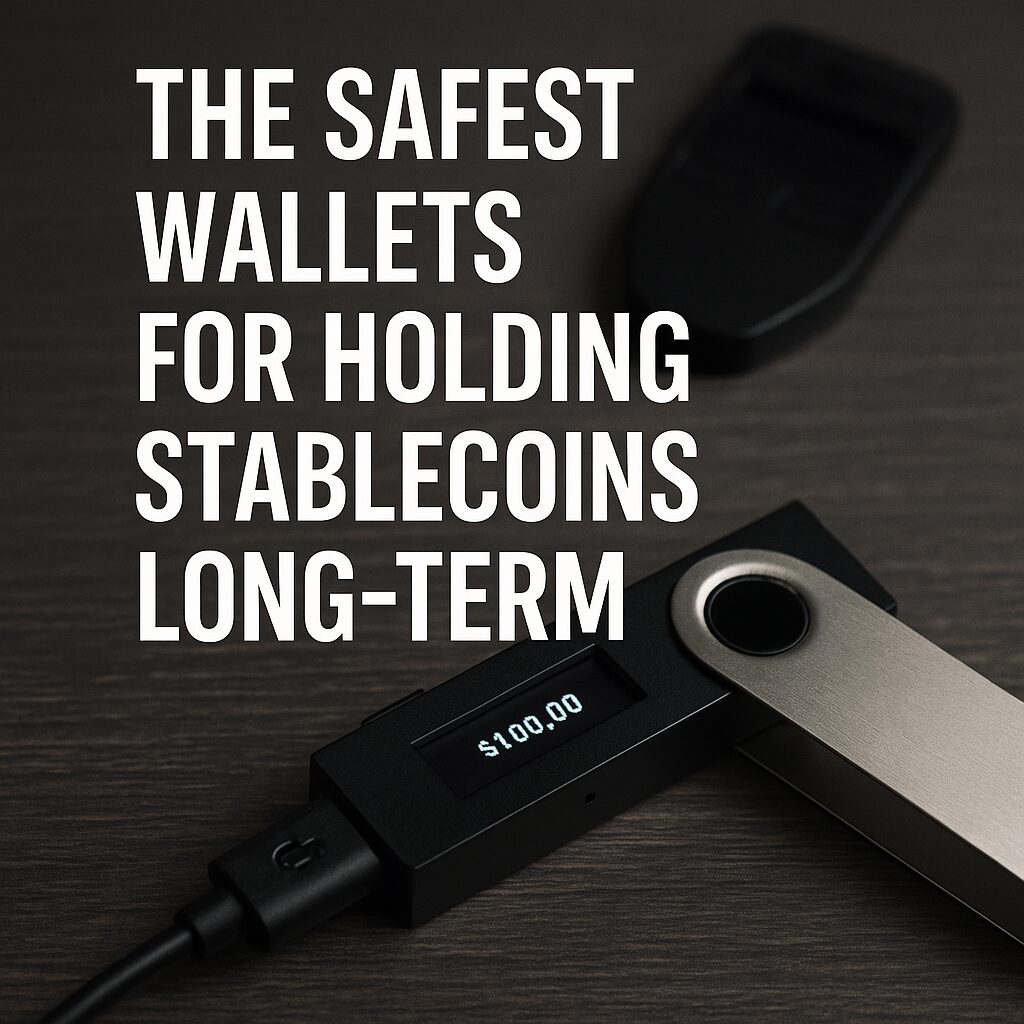Stablecoins may seem like the “safe” part of crypto. After all, they’re pegged to the dollar, aren’t volatile like Bitcoin, and often feel like cash equivalents. But don’t be fooled—holding stablecoins long-term without a secure wallet is one of the riskiest moves in digital finance.
Whether you’re storing $500 or $500,000 in USDT, USDC, or DAI, your choice of wallet is critical. Hacks, exchange bankruptcies, and even government blacklists make custody decisions more important than ever.
Types of Wallets and Their Risk Profiles
Understanding wallet types is the first step in protecting your stablecoins:
- Custodial Wallets (Centralized Exchanges)
Your private keys are held by the exchange. Convenient, but risky—think FTX, Celsius, or Voyager. - Hot Wallets
Internet-connected wallets like MetaMask or Trust Wallet. Great for DeFi, but exposed to phishing and malware. - Hardware Wallets
Offline physical devices like Ledger or Trezor. Extremely secure, especially for long-term storage. - Cold Storage
Air-gapped, offline wallets not connected to the internet. Ideal for very large holdings. - Multi-Sig & DeFi Vaults
Require multiple approvals for transfers. Often used by DAOs and institutional holders.
Top Wallets to Consider
Here are the top wallets that combine usability with long-term security:
- Ledger Nano X
Supports USDT, USDC, DAI, and many others. Bluetooth support and robust ecosystem. - Trezor Model T
Open-source firmware. Excellent for privacy-conscious users and long-term holders. - MetaMask + Ledger
Combine MetaMask’s DeFi access with the offline security of Ledger for a best-of-both-worlds setup. - Argent
Smart contract wallet with built-in DeFi integrations, backup recovery, and no seed phrase needed. - Trust Wallet
A mobile-friendly wallet with broad stablecoin support. Best for smaller amounts on the go. - Safe (formerly Gnosis Safe)
Multi-sig wallet used by DAOs and crypto teams. Ideal for shared custody or business use.
Features to Look For in a Stablecoin Wallet
- Seed Phrase Backup: If you lose this, your funds are gone.
- Stablecoin Support: Ensure USDT (ERC-20, TRC-20), USDC, and DAI are compatible.
- Security Audits: Open-source wallets are easier to vet.
- Multi-chain Access: Ethereum, BNB Chain, Polygon, etc.
- Blacklist Resistance: Avoid custodial wallets prone to freezing assets.
Common Mistakes to Avoid
- Leaving Funds on Exchanges: You don’t own the keys, and that means you don’t own the coins.
- Not Testing Recovery: Always test wallet recovery with a small amount before trusting it with a fortune.
- Mixing Funds: Separate short-term and long-term holdings.
- Ignoring Phishing Risks: Bookmark official sites. Never click wallet links in emails.
How to Store Large vs Small Amounts
- Small Amounts: Trust Wallet or MetaMask with good OPSEC.
- Large Amounts: Use cold storage, multi-sig, or hardware wallets.
- Diversify: Use more than one type of wallet and blockchain.
Example Strategy:
- Daily use: MetaMask + Ledger
- DeFi investing: Argent
- Long-term hold: Ledger Nano X in a fireproof safe
Bonus: Wallet Hygiene Best Practices for Stablecoin Holders
Security isn’t only about the wallet you choose—it’s also about how you use it. Consider the following hygiene tips:
- Use a dedicated device: For large holdings, use a clean laptop or phone only for transactions.
- Update firmware and apps regularly: Hardware and mobile wallets release important security patches.
- Use strong passwords and 2FA: For wallets with login portals or recovery options, always enable two-factor authentication.
- Label transactions: Use notes to identify transfers, making it easier to audit or explain your holdings.
- Be cautious with browser extensions: Some malicious extensions have been caught stealing seed phrases from clipboard memory.
Regional Compliance: Watch Out for Travel and Regulation Risks
Holding stablecoins isn’t just about private key security—your location also matters:
- In some countries, importing or using stablecoins is restricted.
- Border searches could expose hardware wallets if not properly concealed.
- Use encrypted backups and avoid storing recovery phrases in cloud services accessible by local authorities.
- When traveling, consider leaving large holdings in cold storage at home.
The Role of Decentralized Identity and Wallet Recovery
New wallets like Argent and Safe are experimenting with social recovery and decentralized ID:
- You can assign “guardians” (trusted friends or wallets) to help you recover access.
- This reduces the single point of failure from losing a seed phrase.
- For institutions or families managing legacy assets, this adds a layer of continuity planning.
These tools are growing quickly and may become essential for long-term stablecoin management.
Final Thoughts – Treat Stablecoins Like Digital Gold
The crypto community often treats stablecoins as temporary tools—bridges between fiat and crypto. But as their role expands in payments, savings, and remittances, they deserve serious custody strategies.
Whether you’re using stablecoins for yield farming or simply preserving value, the risks of poor wallet management are real—and preventable.
Your stablecoins aren’t truly stable unless your storage is secure.
📌 Coming Up Next
How to Earn Passive Income from Stablecoins Without Falling into Scams
→ In our next post, we’ll reveal how to safely generate yield from stablecoins—without losing funds to Ponzi schemes, rug pulls, or fake platforms. Learn which strategies actually work and how to verify a platform’s legitimacy.
